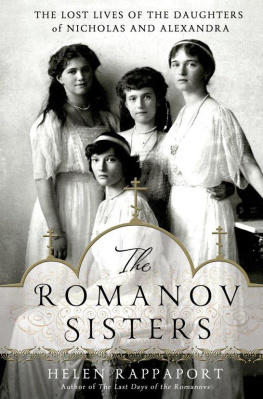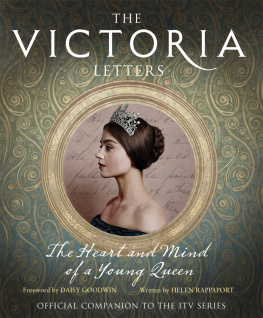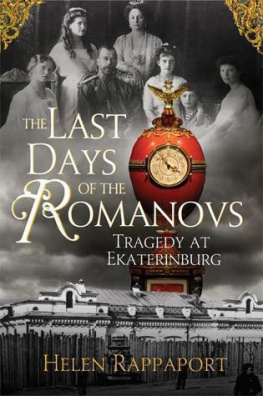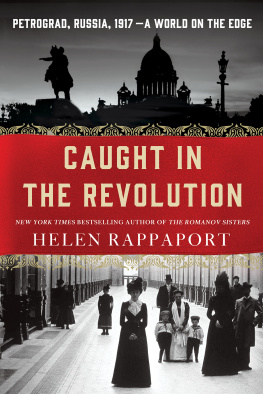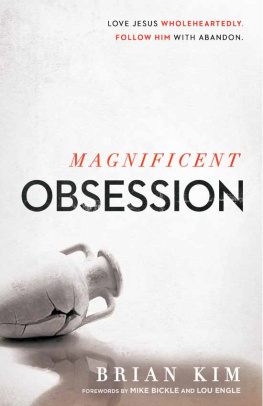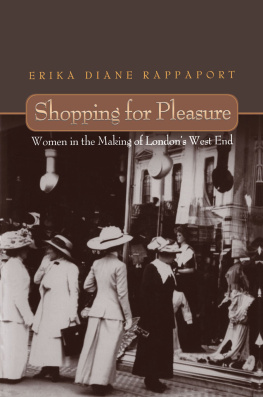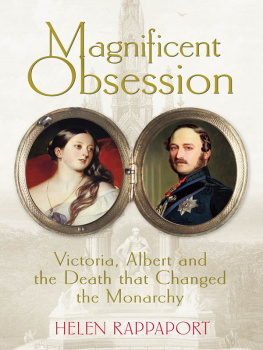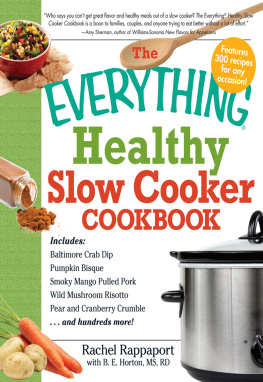Helen Rappaport - A Magnificent Obsession
Here you can read online Helen Rappaport - A Magnificent Obsession full text of the book (entire story) in english for free. Download pdf and epub, get meaning, cover and reviews about this ebook. year: 2012, publisher: Macmillan, genre: History. Description of the work, (preface) as well as reviews are available. Best literature library LitArk.com created for fans of good reading and offers a wide selection of genres:
Romance novel
Science fiction
Adventure
Detective
Science
History
Home and family
Prose
Art
Politics
Computer
Non-fiction
Religion
Business
Children
Humor
Choose a favorite category and find really read worthwhile books. Enjoy immersion in the world of imagination, feel the emotions of the characters or learn something new for yourself, make an fascinating discovery.
- Book:A Magnificent Obsession
- Author:
- Publisher:Macmillan
- Genre:
- Year:2012
- Rating:5 / 5
- Favourites:Add to favourites
- Your mark:
- 100
- 1
- 2
- 3
- 4
- 5
A Magnificent Obsession: summary, description and annotation
We offer to read an annotation, description, summary or preface (depends on what the author of the book "A Magnificent Obsession" wrote himself). If you haven't found the necessary information about the book — write in the comments, we will try to find it.
A Magnificent Obsession — read online for free the complete book (whole text) full work
Below is the text of the book, divided by pages. System saving the place of the last page read, allows you to conveniently read the book "A Magnificent Obsession" online for free, without having to search again every time where you left off. Put a bookmark, and you can go to the page where you finished reading at any time.
Font size:
Interval:
Bookmark:

For Charlie Viney
Peel cut down my income, Wellington refused me rank, the Royal Family cried out against the foreign interloper, the Whigs in office were inclined to concede me just as much space as I could stand upon. The Constitution is silent as to the Consort of the Queenand yet there he was, not to be done without.
Prince Albert, letter to Baron Stockmar, 24 January 1854
He conquered my heart; so that I could not choose but to love him there was an indescribable something about him an elevation, an humility, a power and simplicity, a thorough genuineness of character, a style and tone in his whole manner, opinionswhich made him to me my very ideal of a Christian Prince! What a Godfearing man he was! What a sense of duty he had.
Reverend Norman Macleod, 28 December 1861
For me, life came to an end on 14 December. My life was dependent on his, I had no thoughts except of him; my whole striving was to please him, to be less unworthy of him!
Queen Victoria, letter to King of Prussia, 4 February 1862
Queen Victoria is one of the most written-about women in British if not world history. Her consort Prince Albert has also been the subject of several biographies, as well as studies of his contribution to the arts and British culture. This book is neither a biography of the Queen nor of Prince Albert. Instead it focuses on what is, I argue, a crucial period in her life, one that completely changed the course her reign took for the next forty years and had a profound impact on Britain: the lost ten years from Alberts death at the end of 1861 to the beginning of her re-emergence from deep mourning in 1872.
Much has been written about Queen Victorias later years as the gloomy, humourless, reclusive widow at Windsor, but virtually no attempt has been made to explore the nature of her grief or to describe the circumstances leading up to Prince Alberts death in December 1861 and its catastrophic impact on her. This book seeks to understand why the Queen reacted in the extreme way she did, by explaining her obsessive love for her husband and her total and utter reliance on him. The second half of the book considers Queen Victorias untiring memorialisation of her dead husband in biography, art and architecture at a time when criticism of her withdrawal from public life was mounting.
Prince Alberts death, funeral and the public response to it have been paid surprisingly little attention to date; recent accounts tend to stop abruptly at his deathbed or fast-forward to the Queens life thereafter. This book sets out to describe the effect that death had both on Prince Alberts contemporaries and on the nation at large. With this objective in mind, I have sought out unpublished, forgotten and neglected sources that comment on the Princes declining health, his death and funeral and the Queens reaction to it. In Britain we are blessed with a wealth of published letters, diaries and memoirs from the Victorian period, many of them by personalities who have long since been forgotten and consigned to obscurity, but which nevertheless contain valuable testimony on the impact of Prince Alberts death. It has been a pleasure to rediscover these now-neglected Victorian letter-writers and diarists, who have enlightened and enlivened my research and impressed me with their wonderfully perceptive comments about the Queen, Prince Albert and the true nature of their relationship.
A key resource in the writing of this book has been the Royal Archives in the Round Tower at Windsor Castle. I am indebted to their registrar, Pamela Clark, and her staff for making a range of fascinating material available to me during my research there, and for the permission of Her Majesty Queen Elizabeth II to quote from it, as well as use photographs and illustrations from the Royal Collection. My thanks also go to Sophie Gordon for her assistance in this latter respect.
From Germany, I was able to obtain copies of letters written at the time of Prince Alberts death by the Crown Prince of Prussia and Princess Alice of Great Britain. I am indebted to Christine Klssel at the Arkhiv der Hessischen Hausstiftung, Schloss Fasanerie, Eichenzell, for providing me with transcripts for those of the Crown Prince; and to Professor Eckhart G. Franz at the Staatsarchiv Darmstadt for making available digital images of the original letters by Princess Alice. Quotations from these letters are included with the gracious permission of Prince Donatus von Hessen. I am greatly indebted to Hannah Veale for translating both sets of letters from German, and in particular for her enormous patience in deciphering Princess Alices difficult handwriting.
I would also like to thank a number of British archivists who provided valuable help and access to material: Alan Tadiello at Balliol College, Oxford, for the Queens letters to General Peel in the Morier Family Papers; Nick Mays, at The Times Archive, News International Archive, for those of John Delane and Lord Torrington; Caroline Picco at Cheshire Archives, for providing a photocopy of the Descriptions of the Death of the Prince Consort, 1861 by Arthur Penrhyn Stanley, and for the permission of the present Lord Stanley to quote from it; the British Library, for permission to quote from the Duchess of Sutherlands letters in the Gladstone Papers and from Queen Victorias Album Consolativum; Colin Harris at the Bodleian Library Special Collection, for making available to me the diaries of Katharine Clarendon, John Rashdall and Charles Pugh and the Bodleian Library, University of Oxford for permission to quote from them; Briony Hudson at the Royal Pharmaceutical Society of Great Britain, for allowing me to access the account books of Peter Squire; Phil Tomaselli, for obtaining material for me from the Lord Chamberlains papers at the National Archives, Kew; Helen Burton at Keele University Library, for information on Sarah Hildyard; and Ian Shapiro at Argyll Etkin, for allowing me access to the MS diaries of Sir John Cowell in his collection, as well as providing other materials for my research.
Many other people offered invaluable support, advice and information along the way: Denise Hesselroth alerted me to the underrated diaries of Lady Lucy Cavendish; Paul Frecker provided information on Victorian cartes de visite and images for this book; Kevin Brady shared his research on Princess Alice and her family; Marianne Kouwenhoven in The Hague investigated sources in the archives of Queen Sophie of the Netherlands; Geoffrey Munn at Wartskis kindly showed me items of jewellery relating to the Queen, Prince Albert and John Brown from their private collection; fellow historians David Waller, Matthew Dennison and Hugo Vickers answered my queries and suggested sources. Nicholas Janni and Juliet Grayson suggested sources on death and bereavement, and my dear friend Linda Blair gave me her invaluable views on the same, read sections of the manuscript relating to the Queens grieving and offered insightful comments. Among royalty buffs, Sue Woolmans, Richard Thornton and members of the Royalty Weekend annual conference held at Ticehurst offered valuable support for, and interest in, this project. On a memorable research trip to Whitby to investigate the jet industry, Lynne and George provided a home-from-home at the No. 7 Guest House; Rachel Jones and Matt Hatch at Hamonds Jewellers on Church Street responded generously to my passion for Whitby jet; Peter Hughes, custodian of the wonderfully idiosyncratic Whitby Museum, which has an extraordinary collection of jet jewellery and artefacts, offered valuable background information.
The arguments contained in the Appendix to this book What Killed Prince Albert are my own, based on extensive research and much deliberation. I arrived at my conclusions thanks to the assistance of doctors Simon Travis (Consultant Gastroenterologist) and Chris Conlon (Consultant in Infectious Diseases), who read my draft and offered their comments and observations. Professors Ronald Chaplain (Consultant Oncologist) and Neil Mortensen (Consultant Colorectal Surgeon) also offered valuable advice, as did Dr Anne Hardy on the incidence of typhoid fever in the Victorian period. But, in the end, the conclusions are mine. I would welcome comments and feedback on this book, to my website www.helenrappaport.com
Font size:
Interval:
Bookmark:
Similar books «A Magnificent Obsession»
Look at similar books to A Magnificent Obsession. We have selected literature similar in name and meaning in the hope of providing readers with more options to find new, interesting, not yet read works.
Discussion, reviews of the book A Magnificent Obsession and just readers' own opinions. Leave your comments, write what you think about the work, its meaning or the main characters. Specify what exactly you liked and what you didn't like, and why you think so.


